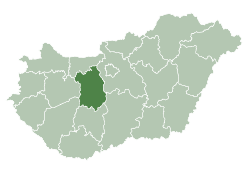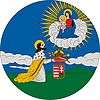Fejér County
| Fejér County | |||||
|---|---|---|---|---|---|
Descending, from top: the Holland House in the park of the Festetich Palace in Dég, Martonvásár area, arboretum in Alcsútdoboz in the Duna-Ipoly National Park | |||||
| |||||
 | |||||
| Country | Hungary | ||||
| Region | Central Transdanubia | ||||
| County seat | Székesfehérvár | ||||
| Government | |||||
| • President of the General Assembly | Dr. Krisztián Molnár (Fidesz-KDNP) | ||||
| Area | |||||
| • Total | 4,358.45 km2 (1,682.81 sq mi) | ||||
| Area rank | 11th in Hungary | ||||
| Population (2011 census) | |||||
| • Total | 425,847 | ||||
| • Rank | 7th in Hungary | ||||
| • Density | 98/km2 (250/sq mi) | ||||
| Postal code |
206x, 209x, 24xx, 700x – 701x, 7041, 80xx, 811x – 815x | ||||
| Area code(s) | (+36) 22, 25 | ||||
| ISO 3166 code | HU-FE | ||||
| Website |
www | ||||
- For the historical county see Fejér (former county).
Fejér (Hungarian pronunciation: [ˈfɛjeːr]) is the name of an administrative county (comitatus or megye) in Central Hungary. It lies on the west bank of the river Danube and nearly touches the eastern shore of Lake Balaton. It shares borders with the Hungarian counties Veszprém, Komárom-Esztergom, Pest, Bács-Kiskun, Tolna and Somogy. The capital of Fejér county is Székesfehérvár.
Geography
Geographically, Fejér County is very diverse; its southern part is similar (and adjacent) to the Great Hungarian Plain, and other parts are hilly (Bakony, Vértes, Gerecse mountains). Lake Velence, a popular resort, is also located there.
History
Before the Conquest
The area was already inhabited 20,000 years ago. When this part of Hungary formed a Roman province called Pannonia, several settlements stood here: the capital was Gorsium, but there were other significant towns too, where present-day Baracs and Dunaújváros are (the towns were called Annamatia and Intercisa, respectively). In the early Medieval period Huns and Avars lived in the area. After 586 several nomadic people inhabited in the area, until Hungarians conquered it in the late 9th century.
From the Conquest until the Ottoman occupation
Hungarians arrived in the area between 895 and 900. The high prince and his tribe settled down in this area. The town of Fehérvár (modern-day Székesfehérvár) became significant as the seat of Prince Géza. Under the reign of his son, King Stephen, the town became the county seat of the newly formed county. Kings of Hungary were crowned and buried in the town until the 16th century.
Fejér under Ottoman rule
Fejér county was occupied by Ottomans between 1543 and 1688. Several of the villages were destroyed, the population dramatically decreased. After being freed from Ottoman rule, local administration was reorganized in 1692. Székesfehérvár got back its town status only in 1703.
Demographics
In 2015, it had a population of 417,651 and the population density was 96/km².
| Year | County population[1] | Change |
|---|---|---|
| 1949 | 295,750 | n/a |
| 1960 | 21.01% | |
| 1970 | 9.33% | |
| 1980 | 7.42% | |
| 1990 | -0.35% | |
| 2001 | 3.69% | |
| 2011 | -1.95% |
Ethnicity
Besides the Hungarian majority, the main minorities are the Roma (approx. 6,500), Germans (5,500).
Total population (2011 census): 425,847
Ethnic groups (2011 census):[2]
Identified themselves: 372 538 persons:
- Hungarians: 356 982 (95,82%)
- Gypsies: 6 277 (1,68%)
- Germans: 5 419 (1,45%)
- Others and indefinable: 3 860 (1,04%)
Approx. 65,000 persons in Fejér County did not declare their ethnic group at the 2011 census.
Religion
Religious adherence in the county according to 2011 census:[3]
- Catholic – 35.7% (Roman Catholic – 35.4%; Greek Catholic – 0.3%);
- Reformed – 10.8%;
- Evangelical – 1.7%;
- Orthodox – 0.1%;
- other religions – 1.3%;
- Non-religious – 19.5%;
- Atheism – 1.5%;
- Undeclared – 29.3%.
Regional structure

| № | English and Hungarian names |
Area (km²) |
Population (2011) |
Density (pop./km²) |
Seat | № of municipalities |
| 1 | Bicske District Bicskei járás |
578.25 | 34,370 | 66 | Bicske | 15 |
| 2 | Dunaújváros District Dunaújvárosi járás |
650.05 | 94,414 | 145 | Dunaújváros | 16 |
| 3 | Enying District Enyingi járás |
433.12 | Enying | 9 | ||
| 4 | Gárdony District Gárdonyi járás |
306.79 | 29,406 | 96 | Gárdony | 10 |
| 5 | Martonvásár District Martonvásári járás |
277.13 | 28,040 | 101 | Martonvásár | 8 |
| 6 | Mór District Móri járás |
439.97 | Mór | 13 | ||
| 7 | Sárbogárd District Sárbogárdi járás |
653.52 | 28,296 | 43 | Sárbogárd | 12 |
| 8 | Székesfehérvár District Székesfehérvári járás |
1,032.05 | Székesfehérvár | 25 | ||
| Fejér County | 4,358.75 | 425,847 | 98 | Székesfehérvár | ||
Politics
The Fejér County Council, elected at the 2014 local government elections, is made up of 20 counselors, with the following party composition:[4]
| Party | Seats | Current County Assembly | |||||||||||||
|---|---|---|---|---|---|---|---|---|---|---|---|---|---|---|---|
| Fidesz-KDNP | 13 | ||||||||||||||
| Movement for a Better Hungary (Jobbik) | 4 | ||||||||||||||
| Hungarian Socialist Party (MSZP) | 2 | ||||||||||||||
| Democratic Coalition (DK) | 1 | ||||||||||||||
Municipalities
Cities with county rights
- Székesfehérvár – county seat; 100,570 (as of 2011)
- Dunaújváros – 48,484 (as of 2011)
Towns
(ordered by population, as of 2011 census)
Villages
- Aba
- Alap
- Alcsútdoboz
- Alsószentiván
- Bakonycsernye
- Bakonykúti
- Balinka
- Baracs
- Baracska
- Beloiannisz
- Besnyő
- Bodmér
- Cece

- Csabdi
- Csákberény
- Csókakő
- Csősz
- Csór
- Daruszentmiklós
- Dég
- Előszállás

- Etyek
- Fehérvárcsurgó
- Felcsút
- Füle
- Gánt
- Gyúró
- Hantos
- Igar
- Iszkaszentgyörgy
- Isztimér
- Iváncsa
- Jenő
- Kajászó
- Káloz
- Kápolnásnyék
- Kincsesbánya
- Kisapostag
- Kisláng
- Kőszárhegy
- Kulcs
- Lajoskomárom

- Lepsény

- Lovasberény
- Magyaralmás
- Mány
- Mátyásdomb
- Mezőfalva

- Mezőkomárom
- Mezőszentgyörgy
- Mezőszilas
- Moha
- Nadap
- Nádasdladány
- Nagykarácsony
- Nagylók
- Nagyveleg
- Nagyvenyim
- Óbarok
- Pákozd
- Pátka
- Pázmánd
- Perkáta

- Pusztavám
- Ráckeresztúr
- Sáregres
- Sárkeresztes
- Sárkeresztúr
- Sárkeszi
- Sárosd

- Sárszentágota
- Sárszentmihály
- Seregélyes

- Soponya

- Söréd
- Sóskút
- Sukoró
- Szabadbattyán

- Szabadegyháza
- Szabadhídvég
- Szár
- Tabajd
- Tác
- Tordas
- Újbarok
- Úrhida
- Vajta
- Vál
- Vereb
- Vértesacsa
- Vértesboglár
- Zámoly
- Zichyújfalu
![]() municipalities are large villages.
municipalities are large villages.
Gallery
- Székesfehérvár, the City of Kings
- Esterházy Mansion, Csákvár
_7.jpg) Károlyi Mansion, Fehérvárcsurgó
Károlyi Mansion, Fehérvárcsurgó_6.jpg) Nádady Mansion, Nádasdladány
Nádady Mansion, Nádasdladány Brunszvik Mansion, Martonvásár
Brunszvik Mansion, Martonvásár- An open-air museum presents the Roman Empire ruins in Tác
 Aerial photography of Székesfehérvár
Aerial photography of Székesfehérvár
References
- ↑ népesség.com, "Fejér megye népessége 1870-2015"
- ↑ 1.1.6. A népesség anyanyelv, nemzetiség és nemek szerint – Frissítve: 2013.04.17.; Hungarian Central Statistical Office (Hungarian)
- ↑ 2011. ÉVI NÉPSZÁMLÁLÁS, 3. Területi adatok, 3.7 Fejér megye, (Hungarian)
- ↑ FEJÉR MEGYEI KÖZGYŰLÉS, (Hungarian)
External links
| Wikimedia Commons has media related to Fejér County. |
Coordinates: 47°10′N 18°35′E / 47.167°N 18.583°E
_5.jpg)
_(13220._sz%C3%A1m%C3%BA_m%C5%B1eml%C3%A9k)_2.jpg)

